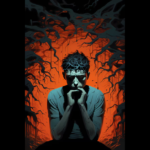“La Venganza de los Punks,” also known as “The Revenge of the Punks,” is a Mexican cult film that was released in 1987. Directed by Damián Acosta Esparza, the movie is part of the “punk-exploitation” genre—a subset of exploitation films that gained popularity in the 1980s. These films often portrayed subcultures, such as punks, in extreme and sensationalized ways, blending elements of horror, crime, and social commentary. “La Venganza de los Punks” is no exception, featuring an outrageous plot, over-the-top characters, and a significant amount of violence and nudity that sparked both controversy and cult status.
In this article, we will explore the various facets of “La Venganza de los Punks,” including its plot, themes, cultural context, and the controversial nudity that plays a pivotal role in the film’s narrative and appeal. Additionally, we will delve into the film’s reception and its lasting impact on both Mexican cinema and the global cult film landscape.
The Plot of “La Venganza de los Punks”
The plot of “La Venganza de los Punks” is a chaotic and violent tale of revenge and rebellion. The story revolves around a gang of punks led by the ruthless character “El Tarzan,” played by Gerardo Zepeda. The gang is notorious for their violent behavior and terrorizes a small town with a series of robberies, assaults, and acts of vandalism. Their reign of terror is challenged when they cross paths with a rival gang led by the protagonist, “El Tri,” portrayed by Juan Valentín.
The film opens with a shocking sequence of violence, establishing the punks as the primary antagonists. They wear spiked leather jackets, heavy makeup, and have a menacing demeanor, representing a stark contrast to the otherwise quiet town. As the punks escalate their criminal activities, the townspeople become increasingly desperate, and the local authorities appear powerless to stop them. This sets the stage for a brutal conflict between “El Tri” and “El Tarzan’s” gang, leading to a series of bloody confrontations.
Throughout the film, the narrative is punctuated by scenes of intense violence, including shootouts, stabbings, and brutal fistfights. The film’s depiction of the punk subculture is highly sensationalized, portraying them as anarchic and devoid of moral compass. This portrayal, while over-the-top, taps into societal fears and prejudices of the time, reflecting a broader trend in media of demonizing subcultures that were perceived as threatening to the status quo.
Themes and Cultural Context
“La Venganza de los Punks” is more than just a violent exploitation film; it is also a cultural artifact that reflects the anxieties and social issues of its time. The film’s depiction of punks as violent criminals can be seen as a reflection of the fears that mainstream society had towards youth subcultures in the 1980s. Punks, with their rebellious fashion and anti-establishment attitudes, were often seen as a threat to social order, and media representations like this film amplified those fears.
The film also taps into themes of revenge, justice, and the breakdown of social order. The title itself—”The Revenge of the Punks”—suggests a narrative driven by a desire for retribution. This theme is common in exploitation cinema, where characters often take the law into their own hands, reflecting a mistrust in institutional authority. In “La Venganza de los Punks,” both the punks and the protagonist’s gang operate outside the law, engaging in vigilante justice that blurs the line between right and wrong.
The setting of the film—a small town besieged by an outside threat—serves as a microcosm for the broader societal anxieties of the time. The town’s struggle to maintain order in the face of chaos mirrors the challenges faced by societies dealing with rapid social and cultural changes. The film’s exaggerated depiction of violence and chaos can be interpreted as a metaphor for the perceived erosion of traditional values and the fear of societal collapse.
The Role of Nudity in the Film
One of the most controversial aspects of “La Venganza de los Punks” is its use of nudity. The film features several scenes of explicit nudity, often in the context of violence or sexual assault. These scenes have been criticized for being gratuitous and exploitative, yet they also play a significant role in the film’s narrative and its shock value.
In exploitation cinema, nudity often serves multiple purposes: it is used to titillate, to shock, and to push the boundaries of what is acceptable on screen. In “La Venganza de los Punks,” nudity is intertwined with the film’s depiction of violence, creating a visceral experience that is designed to provoke a strong emotional reaction from the audience. The scenes of nudity are not presented in a sensual or erotic manner; rather, they are often brutal and disturbing, underscoring the film’s themes of power and domination.
The use of nudity in the film can also be seen as a reflection of the broader exploitation genre’s tendency to sensationalize and objectify. Female characters, in particular, are often depicted as victims of violence, and their nudity is used to heighten the sense of vulnerability and danger. This has led to criticism from some quarters, who argue that the film perpetuates harmful stereotypes and reinforces a culture of misogyny.
However, others argue that the film’s use of nudity and violence is a deliberate commentary on the dehumanizing effects of power and domination. By depicting the punks as both perpetrators and victims of violence, the film blurs the line between aggressor and victim, suggesting that violence begets violence in a never-ending cycle of revenge and retribution.
Reception and Controversy
Upon its release, “La Venganza de los Punks” garnered a mixed reception. While it was embraced by fans of exploitation cinema for its unapologetic approach to violence and its depiction of punk culture, it was also criticized for its graphic content and perceived lack of moral depth. The film’s portrayal of nudity and violence, in particular, sparked controversy, with some critics accusing it of being gratuitous and exploitative.
Despite the criticism, the film quickly gained a cult following, particularly among fans of the exploitation genre. Its over-the-top characters, outrageous plot, and graphic content made it a staple of midnight movie screenings and underground film festivals. For many viewers, the film’s shock value was part of its appeal, offering a raw and unfiltered look at the darker side of human nature.
The film’s controversial content also contributed to its status as a cult classic. In the world of exploitation cinema, controversy often translates to notoriety, and “La Venganza de los Punks” is no exception. The film’s willingness to push the boundaries of taste and decency set it apart from more mainstream offerings, cementing its place in the pantheon of cult films.
Impact on Mexican Cinema and Cult Film Landscape
“La Venganza de los Punks” is notable not only for its content but also for its place in the history of Mexican cinema. The film is part of a wave of Mexican exploitation films that emerged in the 1980s, reflecting a broader trend in global cinema towards low-budget, high-shock-value productions. These films were often produced outside the traditional studio system, catering to niche audiences with a taste for the extreme.
In Mexico, the 1980s were a time of social and economic upheaval, and the exploitation film genre provided a platform for filmmakers to explore themes of violence, crime, and social decay. “La Venganza de los Punks” is a prime example of this trend, using its sensationalized depiction of punk culture to comment on broader societal issues.
The film’s impact on the cult film landscape extends beyond Mexico. Like many exploitation films of its time, “La Venganza de los Punks” found an international audience, particularly in the United States and Europe, where it was distributed on home video and screened at genre film festivals. The film’s blend of violence, nudity, and social commentary resonated with fans of cult cinema, contributing to its enduring popularity.
Analysis of Character Development and Dynamics
The characters in “La Venganza de los Punks” are archetypal, representing exaggerated versions of societal fears and fantasies. The leader of the punk gang, El Tarzan, embodies chaos and destruction. His portrayal as a ruthless, unrepentant villain who revels in violence and degradation reinforces the film’s depiction of punks as anarchic threats to social order. However, his character is also complex in its portrayal of leadership and charisma within the gang, suggesting a nuanced dynamic where fear and respect intermingle.
On the other side, El Tri, the protagonist, represents a counterforce of order and justice, albeit one that operates outside the law. His character is driven by a personal code of honor and a desire for revenge, which puts him on a moral trajectory that is both conflicted and compelling. The film’s narrative arc hinges on the conflict between these two characters, each representing different facets of authority and rebellion.
The supporting characters, particularly the female characters, often serve as symbols of innocence and vulnerability, which are brutally shattered by the punk gang’s violence. The nudity of these characters is frequently used to underscore their victimhood and to heighten the emotional impact of their suffering. This has led to criticism of the film’s portrayal of women, who are often depicted as passive victims rather than active participants in the story. However, it could also be argued that their portrayal reflects the brutal reality of a world where power dynamics are skewed in favor of the strong and the ruthless.
Cinematic Techniques and Style
“La Venganza de los Punks” employs a variety of cinematic techniques that enhance its raw and gritty aesthetic. The film’s visual style is characterized by its use of handheld camera work, quick cuts, and low-angle shots, which create a sense of immediacy and chaos. The frenetic editing style mirrors the anarchic energy of the punk characters, while the use of close-ups and extreme angles amplifies the film’s violent and disturbing imagery.
The film’s soundtrack, featuring a mix of punk rock and traditional Mexican music, adds to the dissonant atmosphere, underscoring the clash between the old and the new, the traditional and the rebellious. The use of music in the film is particularly effective in conveying the emotional tone of the scenes, from the frenetic energy of the gang’s rampages to the somber moments of reflection and loss.
The film’s special effects, though low-budget, are effective in their depiction of violence and gore. The practical effects, including blood squibs and makeup, add to the visceral impact of the film’s violent scenes. This emphasis on practical effects, rather than relying on digital technology, lends the film a sense of authenticity and rawness that is characteristic of the exploitation genre.
Legacy and Influence
Over the years, “La Venganza de los Punks” has maintained its status as a cult classic, influencing subsequent filmmakers and inspiring a new generation of exploitation films. Its blend of social commentary, extreme violence, and controversial nudity has become a blueprint for other films in the genre, particularly those that seek to challenge societal norms and provoke strong reactions from audiences.
The film’s portrayal of punk culture, while heavily sensationalized, has also contributed to its lasting impact. By depicting punks as both antagonists and symbols of societal decay, the film taps into a larger narrative about the fear of the unknown and the desire for control in a rapidly changing world. This theme resonates not only with audiences of its time but also with contemporary viewers who continue to grapple with similar societal anxieties.
The legacy of “La Venganza de los Punks” can also be seen in its influence on Mexican cinema. The film’s success demonstrated that there was a market for exploitation films in Mexico, paving the way for other filmmakers to explore similar themes and styles. Today, the film is often referenced in discussions about Mexican exploitation cinema and continues to be a subject of study for its unique blend of genre elements and cultural commentary.
Controversy and Modern Re-evaluation
In recent years, “La Venganza de los Punks” has been re-evaluated by critics and scholars who are interested in its cultural significance and its place in the history of exploitation cinema. While the film remains controversial for its graphic content and depiction of nudity, some have argued that it should be understood within the context of its time—a period of significant social and cultural upheaval in Mexico.
The film’s portrayal of violence and nudity, while shocking, can also be seen as a form of social critique. By exaggerating the behavior of its characters, the film draws attention to the underlying tensions and conflicts that were present in society at the time. In this sense, “La Venganza de los Punks” can be seen as a reflection of a society grappling with issues of authority, rebellion, and the struggle for control.
Furthermore, the film’s use of nudity, while controversial, serves to highlight the themes of power and vulnerability that are central to its narrative. The portrayal of nudity in the film is not simply for titillation; it is used to underscore the brutal reality of a world where the weak are preyed upon by the strong. This has led some to view the film as a commentary on the dehumanizing effects of violence and the need for justice in an unjust world.
Conclusion
“La Venganza de los Punks” remains a divisive and controversial film that has left a lasting impact on both Mexican cinema and the broader cult film landscape. Its graphic depiction of violence and nudity, while shocking to some, has also contributed to its status as a cult classic, attracting a dedicated fan base and inspiring subsequent generations of filmmakers.
While the film is often criticized for its sensationalized portrayal of punk culture and its use of nudity, it also serves as a reflection of the social and cultural anxieties of its time. By exploring themes of revenge, justice, and the breakdown of social order, “La Venganza de los Punks” offers a glimpse into a world where the lines between right and wrong are blurred, and where violence is both a means of survival and a tool of oppression.
In the end, “La Venganza de los Punks” is more than just an exploitation film; it is a cultural artifact that continues to provoke discussion and debate. Whether viewed as a shocking example of 1980s exploitation cinema or as a commentary on the darker aspects of human nature, the film remains a powerful and enduring work that challenges viewers to confront their own perceptions of violence, nudity, and the human condition.







